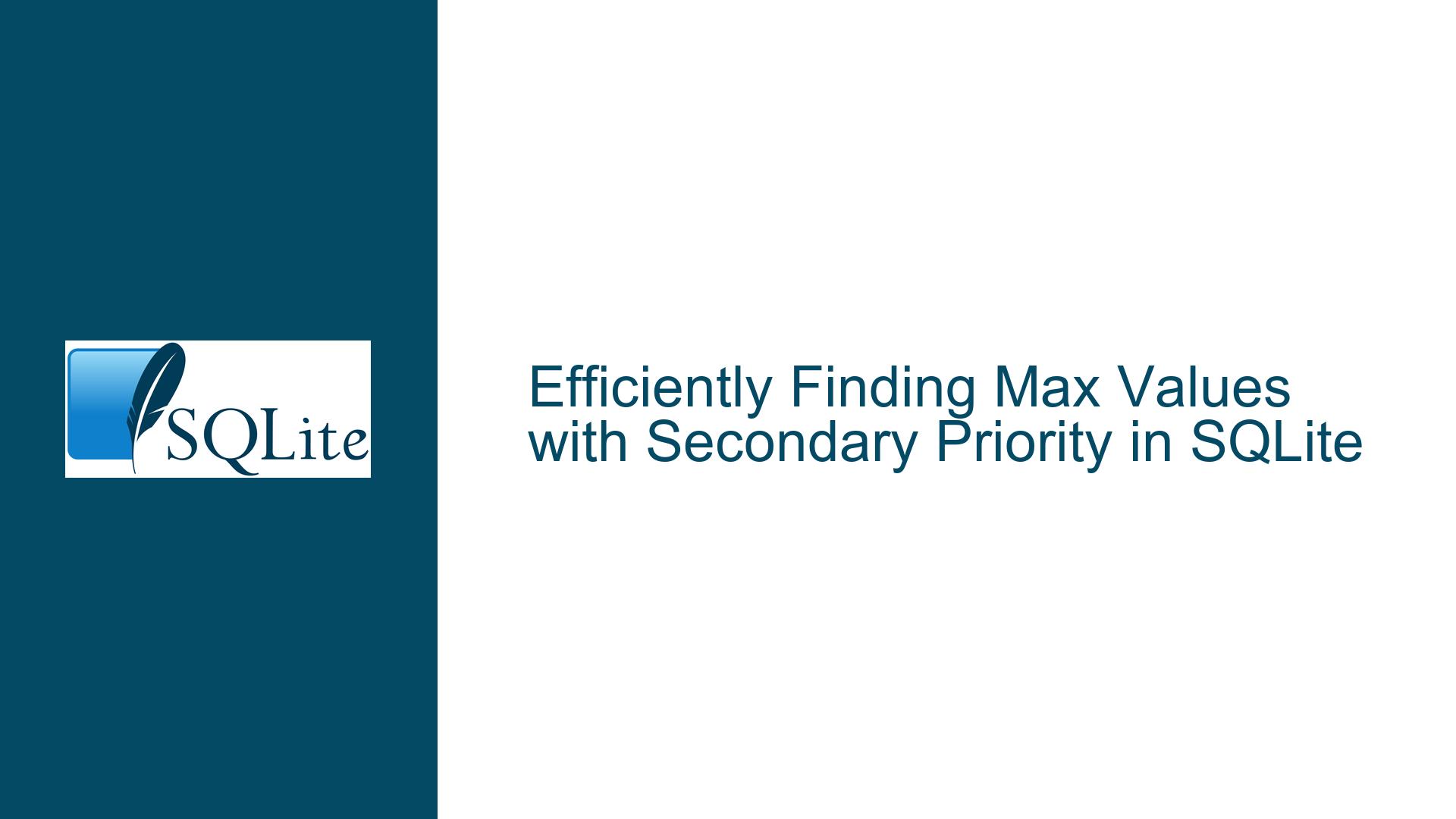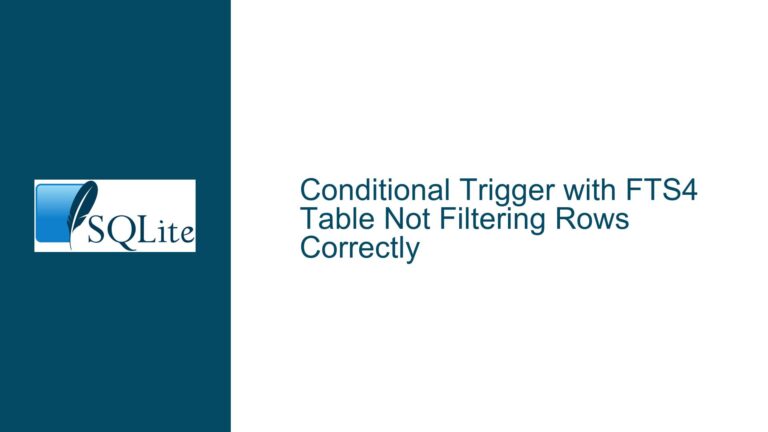Efficiently Finding Max Values with Secondary Priority in SQLite
Understanding the Problem: Grouping with Max Values and Secondary Priority
The core issue revolves around efficiently querying a table to find the maximum value in one column (c) while using a secondary column (d) as a tiebreaker. The table structure includes columns a, b, c, d, and data, where a and b are used for grouping. The goal is to retrieve the row with the maximum value in c for each group defined by a and b. If multiple rows share the same maximum value in c, the row with the maximum value in d should be selected.
The challenge lies in achieving this efficiently without resorting to expensive operations like window functions or nested queries that scan the entire table. The initial approach using RANK() with a window function is functional but inefficient, as it requires assigning ranks to all rows before filtering. This inefficiency is exacerbated when dealing with large datasets, as the entire table must be scanned and sorted.
The problem is further complicated by the desire to avoid aggregating the entire partition. Instead, the goal is to identify the specific row that satisfies the conditions for each group. This requires a solution that minimizes computational overhead while ensuring correctness.
Exploring the Root Causes: Why the Current Approaches Fall Short
The inefficiency of the initial approach using RANK() stems from its reliance on window functions, which inherently require sorting and ranking all rows within each partition. This process is computationally expensive, especially for large datasets, as it involves scanning the entire table and performing sorting operations. Additionally, the results of the inner query cannot be indexed, further compounding the performance issues.
The alternative approach using a custom aggregate function in C addresses some of these inefficiencies by implementing a specialized function to track the maximum values of c and d for each group. However, this solution introduces its own set of challenges. First, it requires writing and maintaining custom C code, which may not be feasible for all users. Second, the implementation does not leverage SQLite’s built-in optimizations, such as indexing, which could further improve performance. Finally, the custom function does not address the potential for parallel processing, which could significantly speed up the computation for large datasets.
Another proposed solution involves using a mathematical transformation to combine the values of c and d into a single value, such as 100 * c + d, and then finding the maximum of this combined value. While this approach is clever and leverages SQLite’s quirks, it has limitations. Specifically, it requires knowing an upper bound for d to ensure that the transformation does not produce incorrect results. This requirement may not always be feasible, especially when the values of d are unbounded or unknown.
The final approach, which uses a common table expression (CTE) and indexing, is more efficient but still has room for improvement. By creating an index on a, b, and c, the query can quickly identify the maximum value of c for each group. However, the subsequent join operation to find the corresponding row with the maximum d adds additional overhead. This approach also requires careful indexing and may not fully exploit SQLite’s capabilities for handling large datasets.
Step-by-Step Solutions: Optimizing Queries and Leveraging SQLite’s Features
To address the inefficiencies and limitations of the current approaches, we can explore several strategies for optimizing the query and leveraging SQLite’s features. These strategies include refining the query structure, utilizing indexing, and considering alternative approaches for handling ties.
Refining the Query Structure
The first step in optimizing the query is to refine its structure to minimize unnecessary computations. Instead of using a window function or a custom aggregate function, we can use a combination of subqueries and joins to achieve the desired result. For example, we can first identify the maximum value of c for each group and then use this result to find the corresponding row with the maximum d.
Here is an example of such a query:
WITH max_c AS (
SELECT a, b, MAX(c) AS max_c
FROM items
GROUP BY a, b
),
max_d AS (
SELECT i.a, i.b, i.c, MAX(i.d) AS max_d
FROM items i
JOIN max_c m ON i.a = m.a AND i.b = m.b AND i.c = m.max_c
GROUP BY i.a, i.b, i.c
)
SELECT i.a, i.b, i.c, i.d, i.data
FROM items i
JOIN max_d m ON i.a = m.a AND i.b = m.b AND i.c = m.c AND i.d = m.max_d;
This query first identifies the maximum value of c for each group in the max_c CTE. It then uses this result to find the corresponding maximum value of d in the max_d CTE. Finally, it joins the original table with the max_d CTE to retrieve the desired row.
Utilizing Indexing
Indexing plays a crucial role in optimizing queries, especially when dealing with large datasets. By creating an index on the columns used for grouping and sorting, we can significantly reduce the computational overhead of the query. For example, creating an index on a, b, and c allows SQLite to quickly identify the maximum value of c for each group.
Here is an example of creating such an index:
CREATE INDEX idx_items_abc ON items(a, b, c);
With this index in place, the query can efficiently scan the table and retrieve the maximum value of c for each group. The subsequent join operations can also benefit from the index, further improving performance.
Handling Ties with Secondary Priority
To handle ties in the values of c, we need to ensure that the query correctly identifies the row with the maximum value of d. This can be achieved by including d in the sorting and grouping criteria. For example, we can modify the max_d CTE to include d in the GROUP BY clause:
WITH max_c AS (
SELECT a, b, MAX(c) AS max_c
FROM items
GROUP BY a, b
),
max_d AS (
SELECT i.a, i.b, i.c, MAX(i.d) AS max_d
FROM items i
JOIN max_c m ON i.a = m.a AND i.b = m.b AND i.c = m.max_c
GROUP BY i.a, i.b, i.c
)
SELECT i.a, i.b, i.c, i.d, i.data
FROM items i
JOIN max_d m ON i.a = m.a AND i.b = m.b AND i.c = m.c AND i.d = m.max_d;
This modification ensures that the query correctly identifies the row with the maximum value of d when there are ties in c.
Parallel Processing Considerations
While SQLite does not natively support parallel processing, we can explore alternative approaches to improve performance for large datasets. One such approach is to partition the data and process each partition independently. This can be achieved by splitting the dataset into smaller chunks and running the query on each chunk in parallel.
For example, if the dataset is large, we can divide it into smaller subsets based on the values of a and b and process each subset independently. This approach can be implemented using external tools or scripts to manage the parallel processing and combine the results.
Final Optimized Query
Combining the above strategies, we arrive at the following optimized query:
CREATE INDEX idx_items_abc ON items(a, b, c);
WITH max_c AS (
SELECT a, b, MAX(c) AS max_c
FROM items
GROUP BY a, b
),
max_d AS (
SELECT i.a, i.b, i.c, MAX(i.d) AS max_d
FROM items i
JOIN max_c m ON i.a = m.a AND i.b = m.b AND i.c = m.max_c
GROUP BY i.a, i.b, i.c
)
SELECT i.a, i.b, i.c, i.d, i.data
FROM items i
JOIN max_d m ON i.a = m.a AND i.b = m.b AND i.c = m.c AND i.d = m.max_d;
This query leverages indexing, subqueries, and joins to efficiently retrieve the desired rows while minimizing computational overhead. By carefully structuring the query and utilizing SQLite’s features, we can achieve the desired result without resorting to expensive operations or custom code.
In conclusion, the key to solving this problem lies in understanding the underlying inefficiencies of the initial approaches and leveraging SQLite’s features to optimize the query. By refining the query structure, utilizing indexing, and considering alternative approaches for handling ties, we can achieve an efficient and scalable solution. While parallel processing is not natively supported by SQLite, partitioning the data and processing it in parallel can further improve performance for large datasets.






